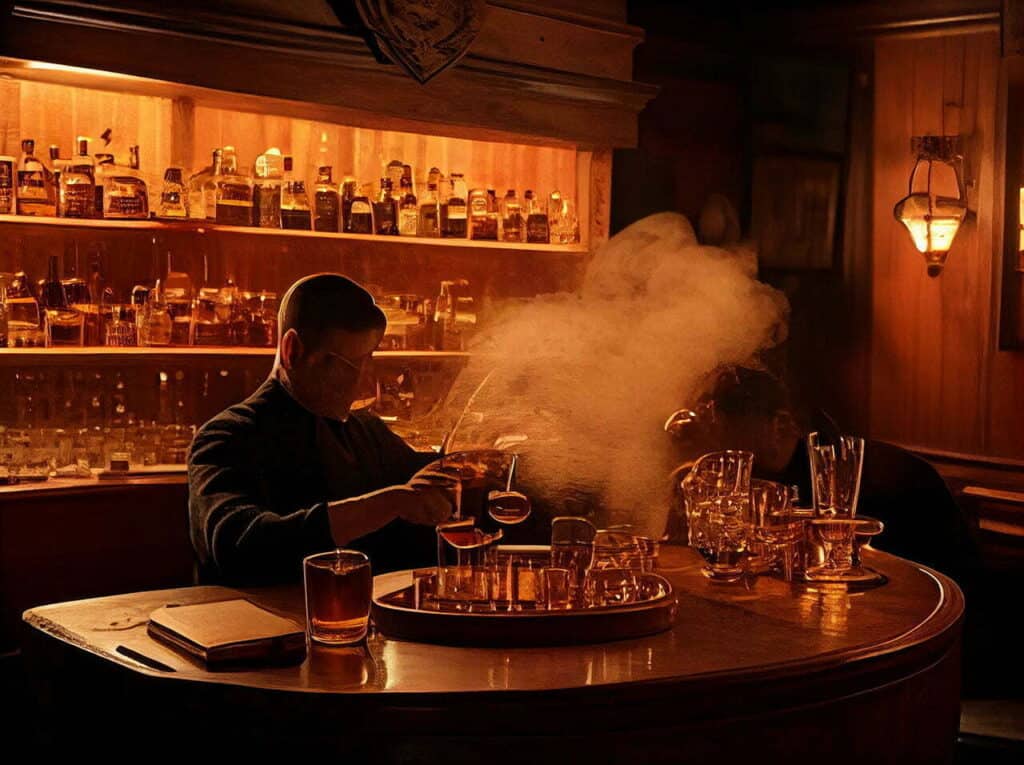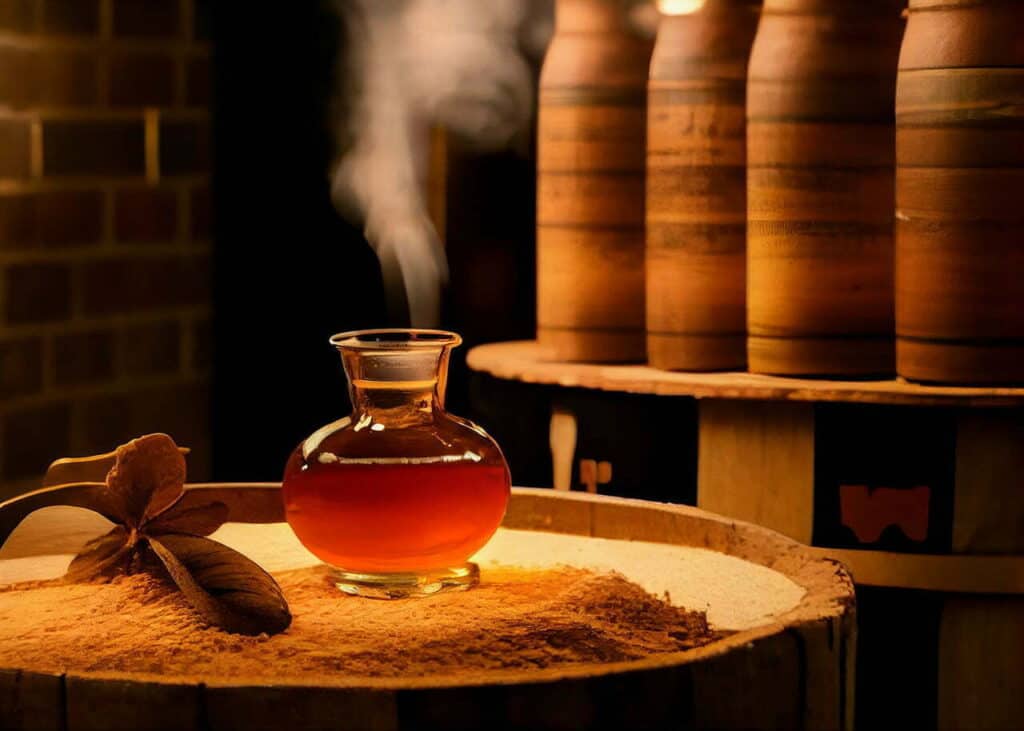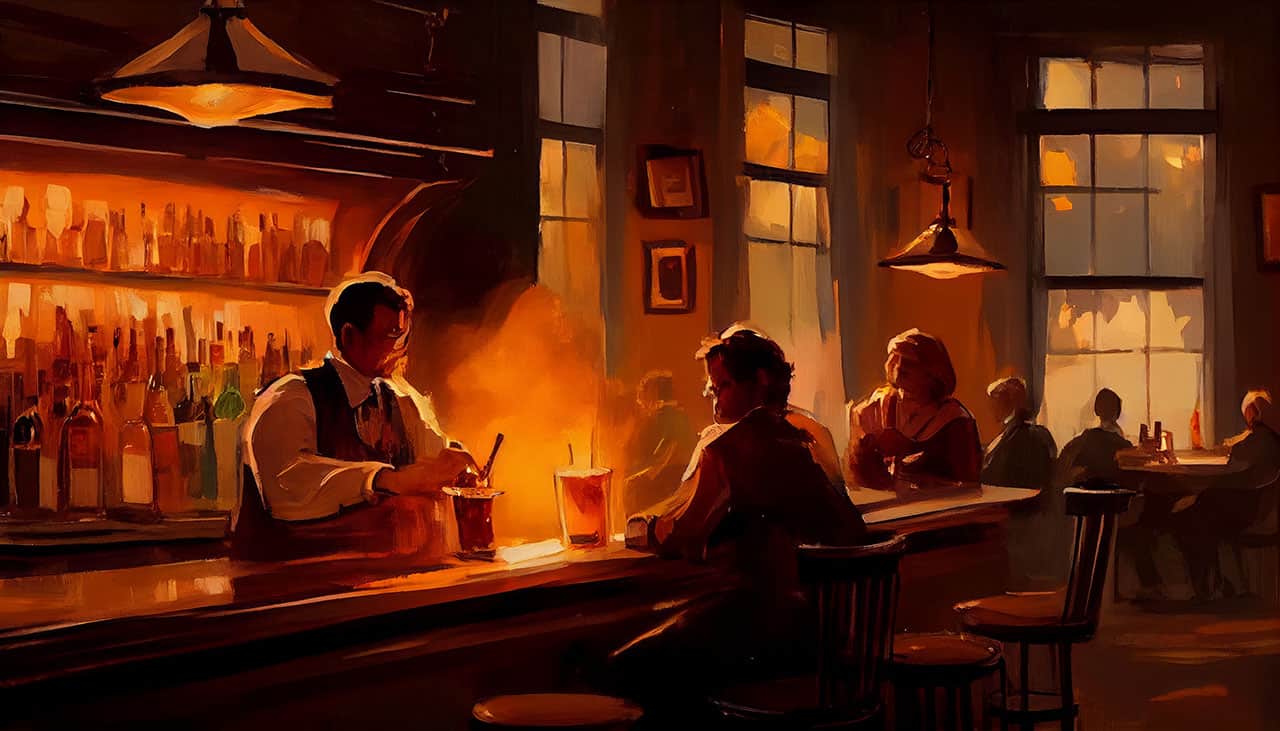Bourbon has been part of the United States since the late 1700s and has been enjoyed by many. Bourbon has a unique aroma and taste, carrying with it its own history, stories, culture, and tradition.
Today, I will be discussing what bourbon really smells like and delving into what makes it so special. Let’s dive into the world of aroma, taste, and tradition when it comes to bourbon.
Table of Contents
Definition of Bourbon
Bourbon is a type of American whiskey that has its roots in Kentucky, a state located in the southeastern United States. The whiskey is made from corn and other grains such as wheat and rye. The spirit must be distilled at 160 proof or less and aged a minimum of two years in charred, new oak barrels.
To be legally classified as “bourbon”, the distillate must be made of at least 51% corn and include no additives or flavorings (other than water). It must also be aged for two years or longer in an unused, charred new barrel made from white oak in order to give it its unique woody aromatic characteristics. Additionally, the whiskey’s mashbill—the combination of grains used to make bourbon—must also contain three primary ingredients: corn, rye and malted barley.
Bourbon has a mild-medium body; it is often sweet yet robust with notes of woodiness, cinnamon, nutmeg and vanilla. Traditionally it has been enjoyed served neat or on the rocks; however it can also be mixed with various soda’s juice concentrates and liqueurs to create twists on classic cocktails like old fashioneds, Manhattans and mint juleps.
Each bottle of bourbon has its own variation of flavors due to different aging conditions and creating processes. Depending on how many times it has been aged (referred to as ‘barreling’) Bourbon can have tastes reminiscent of vanilla bean pods, rye bread doughs or even fragrances like geraniums flowers!
History of Bourbon
Bourbon whiskey traces its roots back to the early days of American distilling. The beverage itself is a form of whiskey that is distilled from a mash of at least 51 percent corn and aged in new, charred oak barrels. It originated in the southern United States in the 19th century, and ever since that time it has been an integral part of southern culture.
Historically, bourbon was made with a combination of grains— corn, barley, and rye — which are called “Mash Bills” by those in the whisky industry. Although there is no definitive answer to where this tradition began (some believe it began with Native Americans who used corn to ferment their own beverages), one thing is certain: bourbon has been around for decades and continues to be enjoyed by many all over the United States as well as internationally. By law, all bourbons must contain at least 51% corn as part of their mash bill making Them imminently American spirits.
Bourbon whiskey contains several distinct aromas that can vary based on how long it was aged or what type of barrel used for aging — such as crisp apple tannins or sweet vanilla notes — but the most prominent aromatic notes are those associated with wood barrel aging, including sawdust and woody nuances. Other aromas sometimes detected include lacquer-like solvent character from higher-proof spirits; citrus fruit flavors if fruit was added during fermentation; and herbal (eucalyptus, menthol) or floral (geranium) aromas when rye grain was used instead of wheat during distillation process.
Aroma and Taste
When you first smell bourbon, you are often met with the characteristic sweet smell of barrel-aged whiskey. It is a complex scent that includes notes of vanilla, wood, and geranium. Each bourbon has its own unique combination of aromas, and with a little bit of exploration, you can truly appreciate the broad range of flavors present in a bottle of bourbon.

Here, we will be discussing the different aromas and tastes that can be found in bourbon and how to detect them.
Vanilla Bourbon
Vanilla is a beloved fragrance, and it’s often associated with dessert. When it comes to bourbons, vanilla is also one of the most recognizable aromas, with a slightly sweet and sugary scent. It’s blended with charred woody notes from the barrel in which it was aged as well as hints of spice, caramel and oak. Vanilla whiskeys also have a hint of lemon citrus on the finish.
Though the vanilla may be prominent initially in the nose, on tasting you’ll likely find that the wood notes are more intense than anticipated due to aging in new charred oak barrels. This is one instance where taking your time with a spirit might be well worth it — if you take your time with this bourbon you will appreciate its subtle nuances and complexity even more!
Wood Barrel Bourbon
The smell of wood barrel bourbon is a powerful and intense one. There are notes of oak and woodiness with a hint of sweetness on the nose. It has hints of dried apricot, light vanilla, baking spices, and molasses. On the palate, it has heavy notes of tobacco and leather combined with nutty flavors like almonds and walnuts. The finish is lingering, lightly charred with sweet oak tannins.
Bourbon that has been aged in a single charred oak barrel may develop additional aroma notes from the charring process. These barrels are often called “inactive” barrels as they don’t continue to add flavor compounds to the whiskey over time. However, when heated during charring a new layer of complexity can be added due to compounds such as vanillin and vanillic acid that are released into the whiskey itself. This creates scents reminiscent of graham cracker crusts or oatmeal cookies which contribute to an overall pleasing aroma experience in wood barrel bourbons.
Geranium Bourbon
Geranium bourbon is a unique and distinctive aroma that has been produced throughout the history of bourbon production. This aroma is often described as a sweet, herbaceous bouquet that has hints of lavender and rose to it. It is typically found in well-aged, high-proof bourbons that have been aged in charred white oak barrels.
When you first smell geranium bourbon, you’re hit with the fragrant sweetness associated with building a home’s foundation on quality craftsmanship. As it develops over time, subtle hints of rosemary, basil, and geranium will begin to emerge. The classic burnt-orange color will be washed away with an alluring hint of cherry blossom and mahogany that coalesce together for an unmistakable richness and pleasant smoky aftertaste.
Overall, the flavor of geranium bourbons can impart a complex balance between sweet and dry notes at once creating an alluring aroma that transports you back in time as if to relive the heyday of America’s traditional whiskey production methods— one sip at a time!
Tradition
Bourbon has a long tradition, going back hundreds of years. It’s associated with the United States of America and the south, and its production is steeped in a deep history of craftsmanship and tradition. It is often seen as an indulgent drink and one to be savored.
But what does bourbon smell like? Let’s dig into the unique aroma and taste of bourbon, and explore its tradition.
Origins of the Bourbon-Making Process
Bourbon is more than just a type of liquor — it is a symbol of American history and culture. Its origins can be traced back to the late 1700s, when settlers from Ireland and Scotland made whiskey in the Appalachian Mountains. The combination of limestone-infused water, air-dried grains, and charred oak barrels created a unique flavor that was soon in demand. Over the years, distillers have experimented with various techniques to bring out individual flavors instead of aiming for uniformity. The result is an incredibly diverse range of bourbons with different noses, tastes and even recipes.
Making bourbon is a highly specialized process that involves soaking mash grains in heated water to convert their starches into fermentable sugars before they’re distilled to create “white dog.” This raw spirit typically has an alcohol content between 65-75%. The liquid then sits in new charred oak barrels for at least two years (in Kentucky) which gives bourbon it’s trademark color and flavor. While aging, natural compounds found in the wood help develop distinctive notes like spice, caramel and vanilla.
The final product reflects the distinctive local environment through terroir — variations in soil composition produce different flavors of grain which can affect the taste of finished bourbons from one region to another. Ultimately, each batch has its own distinct aroma due to volatile chemical compounds found only within that barrel and releases when it’s opened for tasting or bottling.
The Role of Religion in Bourbon-Making
Bourbon is known around the world as a delicious alcoholic beverage with a unique, original flavor. Its Production Code mandates that the liquor be composed of at least 51% corn, aged up to 4 years in charred oak barrels and has a mash bill (or recipe) which includes rye, wheat and barley to achieve its distinctive taste. This adherence to tradition and aging practice can give insight into the spiritual philosophy associated with bourbon production and its place in religious history.
For example, historically, vanilla has been used as an ingredient in several Christian faiths’ blessing rituals. Thus, it is sometimes found in some types of bourbon to add sweetness and complexities from natural flavorings that serve as links between religion and modern production practices. Along those lines, geranium flowers may also be found in certain bourbons for their scent which was traditionally used by Christians for its calming properties during evening or morning masses.
To further add complexity and flavor profile to bourbon production maturing barrels are often stored near a large body of water – usually near rivers, lake shores or ocean beaches—which helps extract additional sweetness flavors from the wood as it ages. This ritual metaphorically alludes to immersing oneself spiritually in divine waters such as baptism where individuals pledge belief towards a greater being. Religious figures have also long touted Kentucky’s limestone-rich spring water sources specifically surrounding the Bourbon Trail purportedly possessing healing properties ideal for distilling whiskey due to its lower sulfur content allowing smoother tasting flavors while emphasizing woody plays on tongue coordination when consumed responsibly.
Ultimately religious traditions provide more than just theoretical connections helping people connect with one another through shared principles while utilizing tangible tools & public inclusion tools like whisky production connecting commodities within society regardless of background beliefs thereby inducing meaningful dialogue around universally accepted topics such as faith through preferred beverages like bourbon that provide cultural understanding for members living within specific communities further exposing different religious faiths practices providing insight into symbolic culture elements integral towards spiritual exploration collectively honoring adults 18+ yrs old assuming personal responsibility or legal age consuming alcohol products under approval regulatory holders where legally permissible.
The Role of Family in Bourbon-Making
Given the long and complex history behind the production of bourbon, it comes as no surprise that the process of creating this mouthwatering spirit is often passed down from generation to generation. After all, it takes skill and dedication to produce a bottle of smooth-tasting bourbon, but experts believe that traditions play an even larger role in producing great whiskey.
For many families associated with bourbon-making, traditions are what brings them closer together and teaches their children valuable lessons about respect for their products (and those of other distilleries). The rituals practiced within each family are unique but generally involve staying together for long periods of time. From unclogging the various machines used by distillers to harvesting a variety of grains for different types of bourbons, working side by side is essential in order to bring out that signature taste.
Understanding the complex flavors and aromas achieved by experimenting with variables like temperature measurements and aging techniques are usually passed down through generations. In many cases, techniques like introducing flavors with specific wood barrels or additives can be traced back generations as well. Thus, family traditions help create a deep understanding and appreciation for trying something new in order to capture new tastes or develop interesting flavor combinations; qualities which has made this spirit so popular since its inception in the late 1700s.
The role of family heritage plays a huge role not only in maintaining quality standards during any craft beverage production process but also instilling important values amongst younger generations learning these craft techniques. Defined best as a “cultural learning process” by those who still practice it today; consciously becoming aware that everyone plays an integral part in bringing satisfaction through the sipping pleasure derived from exactly what goes into such creations is both humbling & motivational all at once when looked at through this lens!
Conclusion
In conclusion, when it comes to aroma, taste, and tradition, there is no denying that bourbon is a complex and varied beverage. With its many flavor notes, there is no one-size-fits-all description of what bourbon smells like. Each variation of the drink has its own individual aroma, from wood barrels to geranium, and from vanilla to orange.
The best way to truly find out what bourbon smells like is to try it for yourself and to identify which of the many scents you like the most.
Summary of Bourbon’s Aroma, Taste, and Tradition
Bourbon is a unique spirit that has a long and rich history in America, and its taste and aroma reflect its multilayered past. Bourbon can range from sweet, warm vanilla notes to more full-bodied grassy and woody flavors that are imparted by the aging process. Even within these broader categories, there are subtle differences in bourbon’s aroma that ensure that each bottle you open has its own special personality.

Although bourbon’s flavor and aroma will depend on the specific ingredients used when distilling it, some of the more common notes include the familiar sweet vanilla of freshly distilled corn whiskey, the aromatic richness of wood barrel aging, the floral notes of geraniums, spice from chili peppers or molasses, and black pepper. Experienced tasters may also be able to recognize hints of cinnamon, leather or licorice. Of course even within all these combinations there is another level of complexity – a unique something that defies description – but nonetheless adds to bourbon’s deep-rooted appeal and brings out memories from long ago.
Through fluctuations in popularity over time, bourbon is still an iconic spirit loved by both whiskey makers and aficionados alike. With its distinct tastes and aromas steeped in tradition, this timeless spirit connects us all whether we enjoy it neat or on the rocks.
Final Thoughts on Bourbon-Making
Bourbon-making involves tradition, technique, and an inspired artistry that creates aromas and tastes that are unique and unforgettable. The barrel-aging process steeps bourbon in character, infusing it with sweet overtones of vanilla, smoky remnants of toasted wood and earthy hints of geranium. The final flavor profile of each batch is as diverse as the craftspeople who make it.
By understanding the flavor components in bourbon, you can better appreciate what goes into creating a memorable batch — from the grains carefully selected for mashing to the aging processes designed to bring out the spirit’s full potential. As you explore different bourbons, remember to savor each sip with respect for its makers and their timeless craft.
Frequently Asked Questions
What does bourbon smell like?
Bourbon has a distinct aroma, with notes of sweet caramel, vanilla, molasses, and oak. It can also have hints of geranium and other floral notes, depending on its production process.
What does vanilla bourbon smell like?
Vanilla bourbon has a sweet, caramel-like aroma, with notes of vanilla and oak. It can also have hints of geranium and other floral notes, depending on its production process.
What does wood barrel bourbon smell like?
Wood barrel bourbon has a distinct aroma, with notes of oak, vanilla, and caramel. It can also have hints of geranium and other floral notes, depending on its production process.


